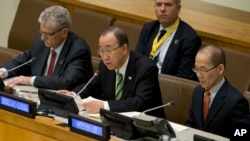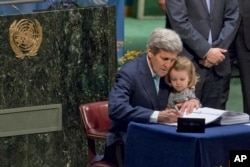White House officials say at least 34 countries have either signed or committed to join the recent climate change deal, putting the agreement on a "much faster trajectory."
"We are within striking distance of the deal coming into force," said Brian Deese, senior advisor to U.S. President Barack Obama.
He said the countries that have committed to the climate change deal reached in Paris in December now represent 40 percent of global greenhouse gas emissions. The agreement will go into force when 55 countries ratify the deal, and when those countries that have joined also account for at least 55 percent of global greenhouse gas emissions.
"It now looks like we are on a much faster trajectory," said Jonathan Pershing, U.S. Special Envoy for Climate Change. He told reporters during a conference call Monday that there is a political momentum "driving things forward."
Deese said the earlier the climate agreement becomes effective, the greater the momentum will be for countries to implement the deal and for other nations to sign on.
The climate deal was unveiled Friday at the United Nations, where top officials from more than 130 countries gathered.
The target date for the deal is 2020. But if enough countries ratify, officials say the agreement could enter into force much sooner — this year or early 2017.
U.S. Secretary of State John Kerry hailed the agreement as powerful, in his remarks at the United Nations before the United States signed the deal on Friday. U.S. lawmakers still need to ratify the deal before the United States can officially be a signatory.
The agreement works to limit global temperature rise to well below 2 degrees Celsius. It also lays out a road map for reducing greenhouse gas emissions and mitigating the effects of a warming planet.
U.N. Secretary-General Ban Ki-moon hailed the Paris accord as a “turning point” in the world's response to climate change.
Many of the countries that have already signed the deal are small island states, which are most threatened by warming oceans and rising sea levels.
The climate change deal calls for developed countries to reach national targets for reducing greenhouse gas emissions every five years, while developing nations are "encouraged" to do so.
There is no penalty for countries that miss their emissions targets, but the agreement has transparency rules to encourage countries to follow through. The deal also calls for wealthy countries to continue to offer financial support to help poor countries reduce their emissions.










